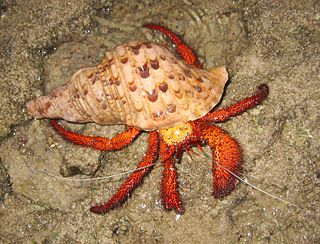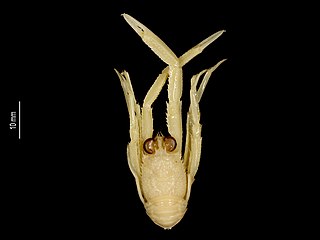
Squat lobsters are dorsoventrally flattened crustaceans with long tails held curled beneath the cephalothorax. They are found in the two superfamilies Galatheoidea and Chirostyloidea, which form part of the decapod infraorder Anomura, alongside groups including the hermit crabs and mole crabs. They are distributed worldwide in the oceans, and occur from near the surface to deep sea hydrothermal vents, with one species occupying caves above sea level. More than 900 species have been described, in around 60 genera. Some species form dense aggregations, either on the sea floor or in the water column, and a small number are commercially fished.

Anomura is a group of decapod crustaceans, including hermit crabs and others. Although the names of many anomurans include the word crab, all true crabs are in the sister group to the Anomura, the Brachyura.

Xanthoidea is a superfamily of crabs, comprising the three families Xanthidae, Panopeidae and Pseudorhombilidae. Formerly, a number of other families were included in Xanthoidea, but many of these have since been removed to other superfamilies. These include Carpilioidea, Eriphioidea, Hexapodoidea, Pilumnoidea and Trapezioidea. Even in this reduced state, Xanthoidea remains one of the most species-rich superfamilies of crabs.

Squillidae is a family of mantis shrimp, the only family in the superfamily Squilloidea. The type genus is Squilla. It is the stomatopod family with the most genera, as follows:
Eurysquillidae is a family of mantis shrimp. Formerly placed in the superfamily Gonodactyloidea, it has since been recognised that eurysquillids are closer to families in the Squilloidea, and so Eurysquillidae has been placed in its own superfamily, Eurysquilloidea. It includes six genera and 30 species

Goneplacoidea is a superfamily of crabs containing 11 extant families, and two families known only from fossils.

The Processidae are a family of shrimp, comprising 65 species in five genera, and the only family in the superfamily Processoidea. They are small, nocturnal animals, mostly living in shallow seas, particularly on grass flats. The first pereiopods are usually asymmetrical, with a claw on one, but not the other. The rostrum is generally a simple projection from the front of the carapace, with two teeth, one at the tip, and one further back.

Bresilioidea is a superfamily of shrimp. It is likely to be an artificial group, containing five families which may or may not be related.

Plesionida is a genus of squat lobsters in the family Munididae. As of 2017, it contains the following species:

Raymunida is a genus of squat lobsters in the family Munididae, containing the following 11 species:

Shinkaia crosnieri is a species of squat lobster in a monotypic genus in the family Munidopsidae. S. crosnieri lives in deep-sea hydrothermal vent ecosystems, living off of the chemosynthetic activity of certain bacteria living on its setae.

Chirostyloidea is an anomuran superfamily with squat lobster-like representatives. It comprises the three families Chirostylidae, Eumunididae and Kiwaidae. Although representatives of Chirostyloidea are superficially similar to galatheoid squat lobsters, they are more closely related to Lomisoidea and Aegloidea together forming the clade Australopoda. No fossils can be confidently assigned to the Chirostyloidea, although Pristinaspina may belong either in the family Kiwaidae or Chirostylidae.
Gonodactylellus is a genus of mantis shrimp. It contains the following species:
Protosquillidae is a family of mantis shrimp. It contains the following genera:

Acanthosquilla is a genus of stomatopod crustacean. The American carcinologist Raymond B. Manning named and first circumscribed the genus in 1963. As of 2018, the World Register of Marine Species recognizes the following eight species:

Acanthosquilla derijardi is a species of stomatopod crustacean. Its distribution is widespread throughout the Indo-West Pacific. The species was initially described by the American carcinologist Raymond B. Manning in 1970. Its junior synonym, A. sirindhorn, was named in 1995 in honor of Princess Sirindhorn of Thailand.

Pariliacantha is a genus of mantis shrimp containing a single species, Pariliacantha georgeorum. The genus and species were first described by Shane T. Ahyong in 2012.

Lithodes aoteoroa is a species of king crab in the family, Lithodidae, and was first described in 2010 by Shane T. Ahyong.
Erugosquilla septemdentata is a species of shrimp in the family, Squillidae, and was first described in 1994 by Shane T. Ahyong as Oratosquilla septemdentata. The name was revised to Erugosquilla septemdentata in 1995 by Raymond B. Manning.
Shane Timothy Ahyong is an Australian zoologist specialising in marine invertebrates. Since 2010 he has worked as a senior principal research scientist at the Australian Museum. Following his Ph.D. he worked as a post-doctoral researcher at the Australian Museum and in 2006 left to manage Marine Biodiversity and Biosecurity Group and Marine Invasives Taxonomic Service within the National Institute of Water and Atmospheric Research in New Zealand.
















